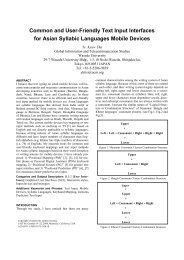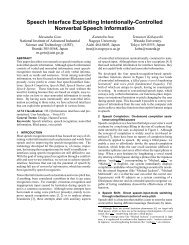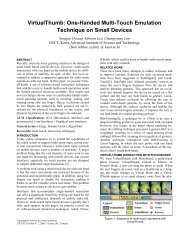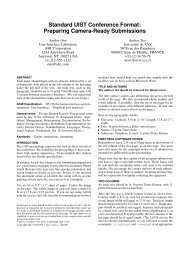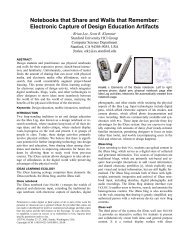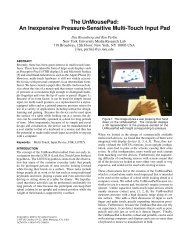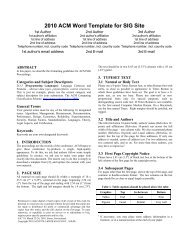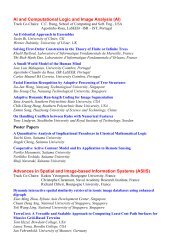API Design Matters Stonebraker and Seltzer - RabbitMQ
API Design Matters Stonebraker and Seltzer - RabbitMQ
API Design Matters Stonebraker and Seltzer - RabbitMQ
You also want an ePaper? Increase the reach of your titles
YUMPU automatically turns print PDFs into web optimized ePapers that Google loves.
ook reviews<br />
<strong>Design</strong>ing with Web St<strong>and</strong>ards (second edition)<br />
Jeffrey Zeldman, Peachpit Press, 2006, $44.99,<br />
ISBN: 0321385551.<br />
Jeffrey Zeldman has written an excel-<br />
lent update of his critically acclaimed<br />
book. This second edition covers<br />
the changes to Web browsers, Web<br />
development techniques, <strong>and</strong> the Web<br />
community’s acceptance of Web stan-<br />
dards in the four years since the first<br />
edition. One of the most significant<br />
changes has been improved support for CSS (cascading<br />
style sheets) layout among all browsers.<br />
Part 1 of the book addresses the importance of Web<br />
st<strong>and</strong>ards. Anyone who is already convinced of the value<br />
of using Web st<strong>and</strong>ards, <strong>and</strong> who doesn’t need the infor-<br />
mation to convince others, can skip part 1 <strong>and</strong> go directly<br />
to part 2, the how-to of designing with Web st<strong>and</strong>ards.<br />
Part 2 begins with a discussion about modern markup.<br />
XHTML is a reformulation of HTML using XML. The next<br />
chapter covers simple rules for converting from HTML<br />
to XHTML. The following chapter begins by walking the<br />
reader through an example of building a Web page using<br />
a hybrid layout. The example demonstrates how to use<br />
CSS to incorporate accessibility into the page, <strong>and</strong> by<br />
extension into the Web site as a whole.<br />
Development of the example Web page is interrupted<br />
to cover CSS basics, after which Zeldman picks up with<br />
the example, using CSS to display the Web page without<br />
having to make changes to the page code.<br />
A discussion of typography follows; it controls how<br />
text looks on the screen. Zeldman debunks many of the<br />
myths surrounding Web accessibility <strong>and</strong> provides tips<br />
for making Web sites more accessible. The final chapter<br />
brings together concepts learned earlier in the book <strong>and</strong><br />
adds a few new techniques to create a CSS design. In the<br />
first edition of the book, many of the techniques were<br />
cutting edge. In the years between editions, many of<br />
these techniques have become part of Web development<br />
best practices.<br />
I highly recommend this book for all Web profession-<br />
als. Those just beginning their careers can learn the right<br />
way to build st<strong>and</strong>ards-compliant Web sites. Those who<br />
have been in the field for decades can learn current best<br />
practices that will make their jobs easier, while still meet-<br />
ing the requirements of their clients. —Will Wallace<br />
Expert VB 2005 Business Objects (second edition)<br />
Rockford Lhotka, Apress, 2006, $59.99,<br />
ISBN: 1590596315.<br />
If you are looking for a good .NET<br />
companion framework, you should<br />
seriously consider CSLA (component-<br />
based scalable logical architecture).<br />
Rockford Lhotka designed it to ease<br />
the development of business objects<br />
that must be reused <strong>and</strong> deployed in<br />
a variety of distributed scenarios—for<br />
example, two-tier architectures with desktop interfaces or<br />
three-tier architectures with Web interfaces. The result is<br />
a framework that provides built-in support for multilevel<br />
undo/redo, business rules, two-way data binding for both<br />
Windows <strong>and</strong> Web forms, object persistence, custom<br />
authentication, <strong>and</strong> integrated authorization.<br />
This book reports on the CSLA framework. Its 12 chap-<br />
ters are well organized <strong>and</strong> easy to follow for the average<br />
.NET programmer; a few sections delve into some .NET<br />
intricacies that are necessary for implementing two-way<br />
data binding, for example, but Lhotka has managed to<br />
take the reader from the essential concepts to the intrica-<br />
cies so that they are easy to underst<strong>and</strong>. Furthermore,<br />
readers who are not interested in the details may skip<br />
these sections safely.<br />
The first chapter is an essay on distributed architec-<br />
tures in which the emphasis is on the distinction between<br />
logical <strong>and</strong> physical models <strong>and</strong> the mappings between<br />
them; this chapter explains the motivation for a frame-<br />
work such as CSLA, whose design goals <strong>and</strong> main features<br />
are presented in chapter 2. Chapters 3 through 5 deal<br />
with the implementation of the framework itself. The rest<br />
of the book reports on using the framework to implement<br />
a small, but not trivial, project management system to<br />
which the user can have access through a typical desktop<br />
application, Web page, or SOAP.<br />
I must confess that I enjoyed evaluating this book, <strong>and</strong><br />
I definitely recommend it to programmers who develop<br />
typical business applications <strong>and</strong> wish to take the .NET<br />
framework a step further. I also think that it is a valu-<br />
able resource for information technology students since<br />
Lhotka’s style of writing is didactic <strong>and</strong> the design of<br />
the framework is quite clean. For readers who prefer C#,<br />
another version is available. —Rafael Corchuelo<br />
Reprinted from Computing Reviews, © 2007 ACM, http://www.reviews.com<br />
56 May/June 2007 ACM QUEUE rants: feedback@acmqueue.com




